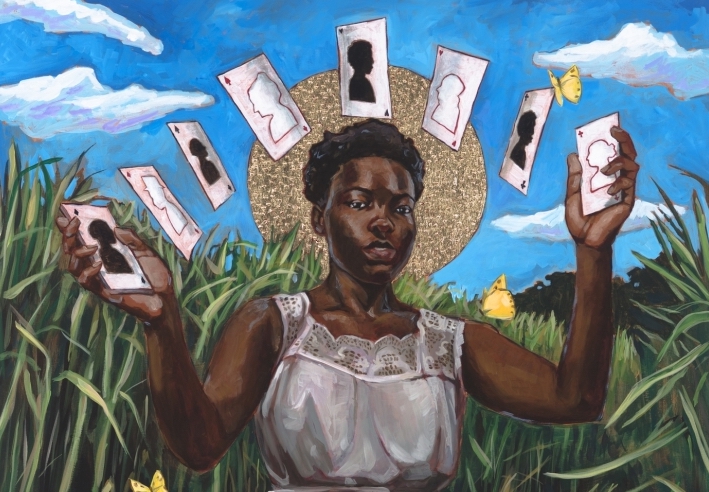Published originally at Hyperallergic on 9.8.2017: Following an employee complaint, Stephen Towns removed his paintings from his solo show at Rosenberg Gallery. The decision has since inspired some much-needed dialogue.
Essay by Cara Ober
In 1967, author William Styron won a Pulitzer Prize for The Confessions of Nat Turner. The novel retold the story of a real historic event — the 1831 slave revolt of Southampton County, Virginia — narrated from the imagined perspective of Turner, the educated and highly religious slave who led our nation’s bloodiest slave revolt.
Although white militias ended the rebellion within a few days, the rebel slaves liberated a number of local plantations and killed between 55 and 65 white slave owners, including women and children. After two months in hiding, Turner was captured and later hanged, and his corpse was subsequently beheaded, quartered, and flayed (his body parts were auctioned off and his skin was made into collectible items). In the aftermath, approximately 120 slaves and free African Americans were murdered in the region by white militias and mobs as retribution, and southern state legislatures passed new laws prohibiting the education of slaves and restricting the civil rights of free black people in order to prevent future revolts.
As with most American history, Nat Turner’s story has been told and retold by white male authors, including Styron, with fewer known works of historical research, art, or literature about him by black authors. It is within this context that the Baltimore-based, African American artist Stephen Towns made his own series of paintings and quilts based on Turner’s rebellion, after he received research funding from a Rubys Grant in 2015.
 The taped squares placed in lieu of Stephen Towns’s painting at Rosenberg Gallery, Goucher College (photo by the author for Hyperallergic)
The taped squares placed in lieu of Stephen Towns’s painting at Rosenberg Gallery, Goucher College (photo by the author for Hyperallergic)
The Joy Cometh in the Morning series presents six painted figures, each representing a martyr from the rebellion — individuals who made a choice to wage war for their freedom for personal and spiritual reasons, knowing that their chances for success or survival were zero. In Towns’s vision, each wears a noose around their necks, held in place by one raised fist, a gesture of black power. In this pose, the artist empowers each individual to be seen as master of their own destiny, to be read as tragic heroes, and to command respect and admiration in the face of sacrifice.
On view at Goucher College’s Rosenberg Gallery in a solo show titled A Migration, the series (one of several in the show) recently provoked a complaint from an African American employee. The artist responded by asking gallery director Laura Amussen to remove the paintings on August 20, and to replace them with taped squares on the gallery wall where each had been. This decision has inspired divisive reactions on social media that in many ways recall the debates that arose from Styron’s novel 50 years ago.
Read the entire essay at Hyperallergic here.






